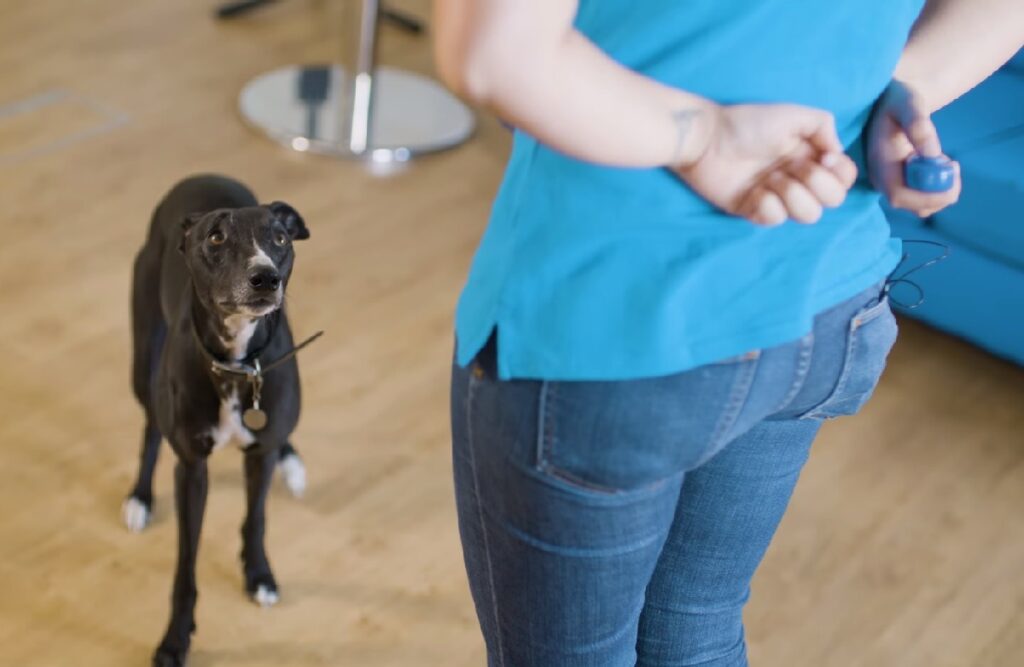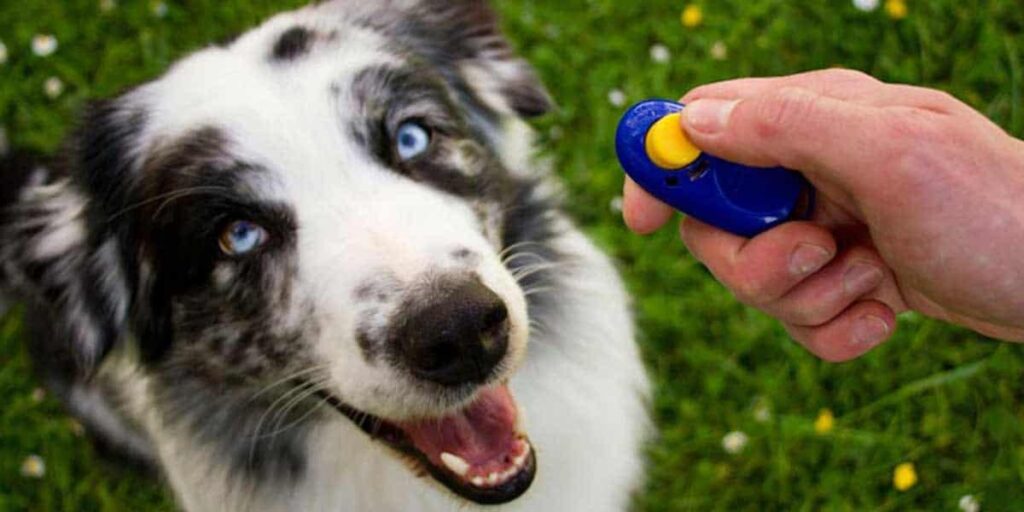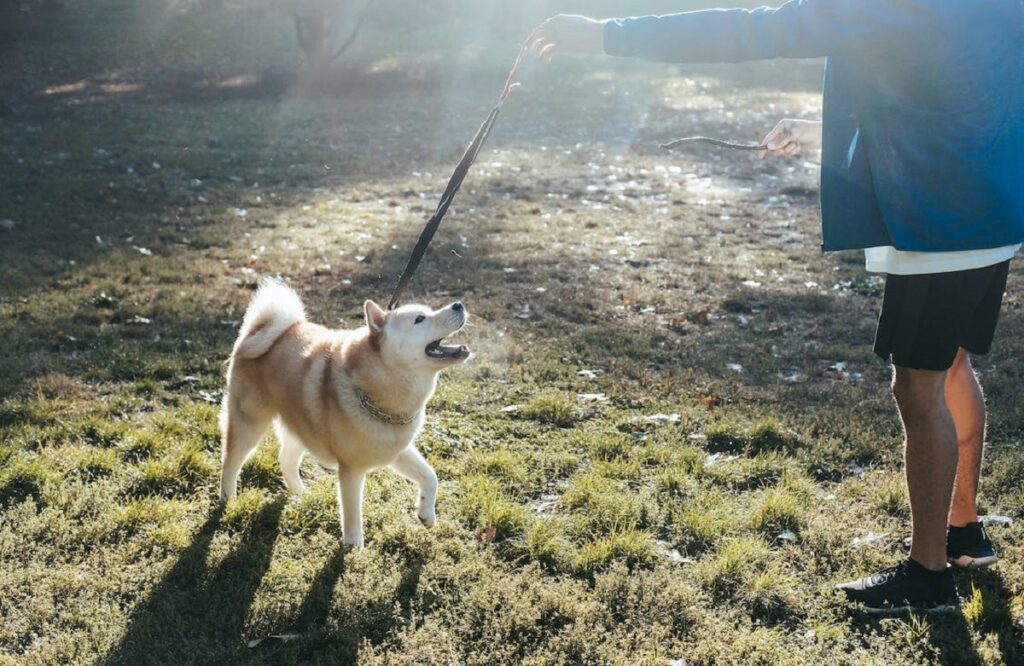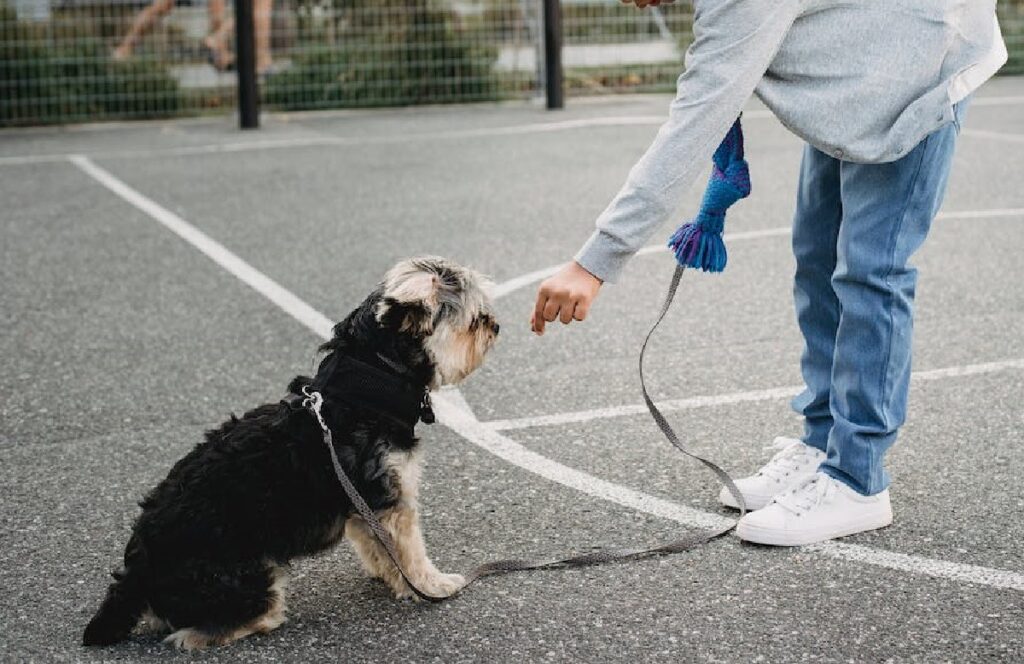
How to Clicker Train a Dog: Successful Clicker Training Sessions and Basic Commands
A dog’s best friend is clicker training because this method includes your presence, encouraging behavior, and goodies. Dogs pick things up quickly if they get what they want, and teaching them with positive reinforcement builds better bonds between you and your pet. Greetings from the magical world of “How to Clicker Train a Dog.” We’ll examine the straightforward yet effective practice of clicker training in this guide, where a single click can have a big impact.
When you use clicker or marker training to teach your dog a command, such as teaching a young dog not to bite, they will learn that positive behavior is rewarded at that precise moment.
Join us as we go on a journey of developing trust, teaching tricks, and creating moments of pure joy with your canine friend, whether you’re just starting as a pet parent or an experienced dog specialist. Together, let’s uncover the techniques of effective clicker training and create the groundwork for a happy, well-mannered dog!
What is Clicker Training?
One excellent tool for positive reinforcement training with dogs is a clicker. Your tongue, your fingers, or any object that produces a slight, audible clicking sound can all be considered clickers.

Clicker training is similar to spoken dog training, however it involves a single click as opposed to barks and woofs! Imagine having a magical button that rewards your dog with a “Great job!” each time they perform a task correctly.
The clicker is that! It’s a little gadget that emits a unique sound that your pet will find far more thrilling than snapping your fingers. You press the clicker when your dog sits on cue or performs a neat trick, and then it’s party time!
Some Important Advantages of Clicker
Clear Signal
Clicker training uses a distinctive sound to communicate when your dog performs a desired behavior.
Instant Recognition
The click provides immediate feedback, helping your dog understand exactly what they did right.
Positive Reward
Follow the click with a reward, reinforcing positive behavior and creating a strong association.
Versatile and Fun
Suitable for teaching various commands, tricks, and behavior corrections, making training engaging and enjoyable.
What is Operant Conditioning?
Operant conditioning is a learning process that focuses on how behavior is influenced by its consequences. In this method, behaviors are either strengthened or weakened based on the positive or negative outcomes that follow them.
The renowned Nobel Prize-winning physiologist, neurologist, and inventor of operant conditioning and the first dog training clicker is famous for his numerous canine studies, including an invasive saliva test that includes the sound of a bell.
After observing dogs, Pavlov communicated to them when it was time to eat food with a bell. Dogs slobber if you keep them waiting for food, which is obvious to even the non-scientist. By changing the order, Pavlov taught the lab dogs to link sound with food even without any actual food.
This method, known as operant conditioning, teaches dogs to act in a particular way in response to the application of a stimulus or reward.
Learn how the techniques of reinforcement dog training—which include rewards and praise—can mold your dog’s behavior into one that promotes peace in your relationship.
How To Use a Clicker for Training Your Dog
When you train your dog using a clicker, it’s like opening a secret language that your pet can understand. Your dog will know they’ve got it when they hear the clicker, a tiny, portable gadget that makes a unique noise that signals “Yes!” directly.

This is the simplified edition; to utilize a clicker, dog trainers teach their pets to associate the clicker mark with the treat of their choice through a technique known as loading the clicker. After 15 to 20 repetitions, the majority of dogs respond appropriately. This approach differs from electric collar training, which some dog owners consider to be brutal.
Here’s a summary of how to utilize this useful tool to its full potential:
Start with the Basics:
- Start in a peaceful, distraction-free place.
- Click to introduce the clicker, then provide a treat right away to establish a good relationship.
Timing is Everything:
- When your dog shows the required behavior, click the button.
- Reward the clicker after it has been made to strengthen the link between the click and the desired result.
Teach Commands with Precision:
- Use the clicker for basic commands like sit, stay, and come.
- Gradually introduce the clicker to more challenging tasks, clicking at the exact moment your dog gets it right.
Consistency and Patience:
- When you click to encourage desired actions, do so consistently.
- Patience is key; give your dog time to understand and respond to the click.
Positive Reinforcement Rules:
- Always follow the click with a reward, whether it’s treats, affection, or playtime.
- Positive reinforcement creates a joyful learning experience for your dog.
How to Clicker Train a Dog
Clicker training your dog is like speaking their language with a special sound. Imagine a quiet space where you click the clicker and instantly make your dog happy with a treat, creating a special link. It may sound tricky to integrate the clicker dog method of training into your routine, but all it takes is little practice. When your dog responds appropriately in a public park, you’ll be thrilled to see them succeed and feel satisfied.
Introduce the Clicker to Your Dog

Above all, regard the time you spend with your dog.
- Bring along your dog’s snacks of choice and a half-cut clicker to cut low on calories.
- Pick a peaceful place or a quiet park area.
- Give your dog a treat immediately as you introduce the clicker, marker sound, or other noise you’ll employ moving ahead. Just by allowing the dog to hear the sound you activate, you are rewarding it.
- Give the treat some verbal and tactile praise.
- To make the connection, repeat the clicker noise and reward procedure
For Every Desired Behavior, Create a Marker Word
Follow these simple instructions;
Choose a Clear Word:
- Pick an easy and distinct word like “Good” or “Yes.”
Sync with the Clicker:
- Say your chosen word right after using the clicker.
Be Consistent:
- Use the word consistently in all training sessions.
Link with Rewards:
- Always follow the word with a treat or praise.
Apply Everywhere:
- Integrate the word into different training scenarios.
Repeat for Clarity:
- Repeat the process for a clear understanding.
Move Towards Independence:
- Aim for the word to signal reinforcement on its own.
Celebrate Success:
- Cheer when your dog responds to the word alone.
Instead of introducing too many commands at once, concentrate on perfecting the sequence.
- Oral Command
- Choose Reward
Release command markers such as break and free are also utilized in clicker training. Once your dog is proficient in hand or verbal cues, the objective is to ease them off of the clicker and treats.
Basic Commands of Training

Building a strong bond with your dog through dog training is both enjoyable and necessary. The majority of experienced dog owners will concur that dogs benefit greatly from routines and self-assurance in your guidance.
Sit:
The most widely accepted and easily executed command is to sit.

- Grip the treat in your hand.
- As you raise the treat above the dog’s head, say “Sit.”
- When your dog sits, give them a treat!
- Do this again and again.
Stand:
- Your dog should be seated.
- Pull a reward straight back from your dog after holding it up to its nose. Your dog will get to its feet as they follow the treat.
- Use a clicker to indicate when your dog stands, a marker word such as “Yes,” or praise. Then, while your dog is still standing, give them the treat right away.
- It’s time to fade the lure after a few tries. This time, entice your dog to stand by holding out an empty hand. Once your dog stands, click, mark, or give them praise again. Then, using your other hand, swiftly offer a goodie.
- You’ve taught your dog a hand signal when they can consistently follow your empty hand by pulling it parallel to the ground in your direction. You can now provide a spoken cue. Say “Stand” just before you make your hand gesture. Next, click, mark, commend, and award as previously.
- Your dog should react to the verbal cue alone after a sufficient number of repetitions.
Come:

- Start with your dog wearing a long leash, gently tug on it when it responds to your call.
- Press and hold the clicker when it starts to approach you in the correct direction.
- When it returns to you, could you give it some praise and food as a treat?
- You’ll eventually be able to stop using the leash completely.
Heel:
- Indoor is the greatest place to start.
- Attract your dog to follow you around with a nice treat by holding it in your palm.
- As a marker, use the word “heel,” and click whenever it stays in the designated area, moving one step in front of you and one step behind you.
Stay:

- Make the click sound every few seconds as long as your dog is still to teach it to stay.
- For each of your workouts, start with 10 seconds and gradually increase the length of time it holds the posture.
- Aim for five minutes, if possible.
Practice, Patience, and Consistency
Dogs need consistent training and reinforcement because they are not quick learners. You should budget at least a few hours every week for your dog’s training. Your dog will have a learning curve and get better with each session as you put in the time. If your dog is displaying indications of burnout or you are feeling frustrated, do not train it at that time.
Consistently training for shorter lengths of time is preferable to less frequent training for longer durations of time. Aim for two sessions of 15 to 20 minutes a day, separated by a few hours. Since consistency is essential, be aware that a dog will start to regress if you stop rewarding its behavior.
Key Strategies for Effective Clicker Training with Your Dog
Many people find that clicker training is simple, and they also love spending time with their closest friends.
Gentle Introduction:
- Start clicker training in a calm setting.
- Click and reward for instant positivity.
Timing Precision:
- Click the moment your dog behaves well.
- Follow with a treat for reinforcement.
Master the Basics:
- Begin with simple commands like sit.
- Progress to advanced tricks gradually.
Consistent Clicking:
- Be consistent with clicker use.
- Reinforce a stable click-reward link.
Positive Pairing:
- Associate clicks with treats, praise, or play.
- Enhance the training experience positively.
Short, Sweet Sessions:
- Keep training sessions brief.
- End on a positive note each time.
Adapt to Environments:
- Train in various settings.
- Generalize commands for versatility.
Patient Observation:
- Observe and adapt to your dog’s cues.
- Tailor your approach accordingly.
Reduce Treat Dependency:
- Gradually decrease treatment frequency.
- Maintain the positive clicker cue.
Cheers for Progress:
- Celebrate small victories and progress.
- Strengthen the bond through positive reinforcement.
The Benefits of Clicker Training

Clicker training benefits are as follows,
- Your dog picks up desirable behavior
- increases your dog’s and your confidence
- Enhances your relationship with each other Quick training approach
- It’s a lot of fun.
- teaches your dog to react fearlessly and to trust its instincts
- Your errors have less of an impact on the outcome and reaction of the dog.
- It speeds up a dog’s learning of both simple and complex answers.
How and When to Employ Clicker Training
When clicker training is started in an under-observation, distraction-free setting, it works best. When your dog is at ease and open to training, start setting the foundation for effective communication. Establishing a solid foundation by beginning with fundamental commands like sit, remain, or come helps you create a language that your dog can comprehend.
In clicker training, timing is essential. As soon as your dog exhibits the required behaviour, click to establish a direct link between the click and good deeds. Play, compliments, or other forms of positive reinforcement strengthen this bond. Maintaining consistency in your clicks and commands helps to speed up the learning process by reinforcing the knowledge.
Make sure that training sessions are concise and entertaining, creating a favorable impression. To help your dog respond to commands in a variety of scenarios, practice clicker training in diverse contexts. This flexibility demonstrates the adaptability and potency of clicker training as a potent tool for communicating with your dog.
Learn more about how to become a dog trainer and enhance your skills in fostering a strong bond with your four-legged friends.
FAQs
What is the Meaning of Click?
The click serves as a precise signal, indicating to your dog that they’ve performed the desired behaviour.
What Can I Teach My Dog With Clicker Training?
Clicker training is versatile; you can teach basic commands like sit, stay, or come, as well as more advanced tricks with positive reinforcement.
Is a Clicker Bad for a Dog?
No, when used correctly, a clicker is a neutral and effective communication tool, promoting positive behavior through association with rewards.
How Long Does It Take to Clicker Train My Dog?
The duration varies, but consistency and short, enjoyable sessions can lead to noticeable improvements in your dog’s behavior within a few weeks.
Conclusion
In conclusion, positive reinforcement coupled with clickers for dog training creates a powerful relationship in dog education. Treats, praise, or play augment the learning experience, and the unique click becomes a language of clarity, communicating desired activities. Training becomes a constructive and pleasurable activity when it is conducted consistently and in short, enjoyable sessions.
Discover how clicker training can be tailored to your needs, from simple commands to complex tricks, to promote not only obedience but also a pleasant, healthy relationship with your pet.




